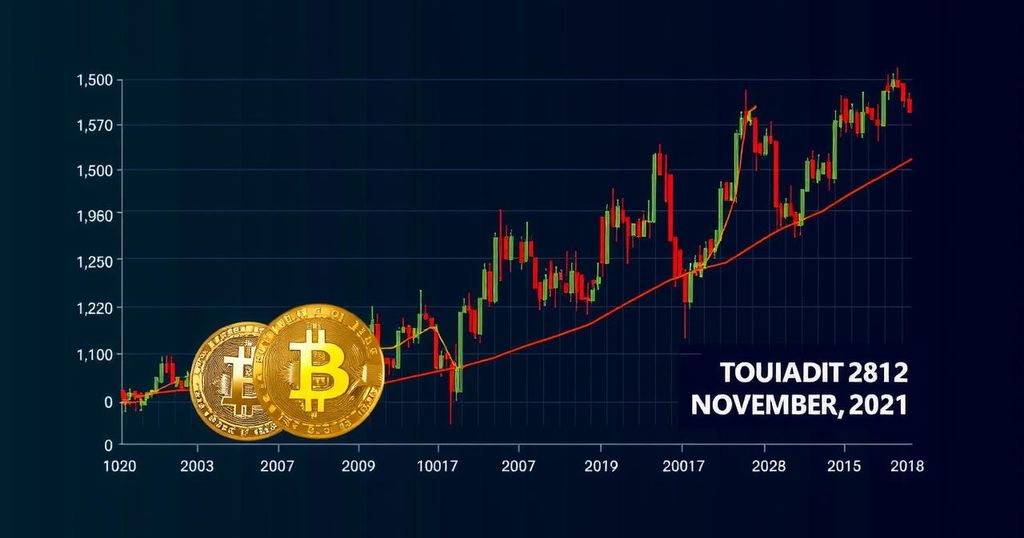Bitcoin Price Decline Below $59,000: An Analysis of Market Dynamics
Bitcoin has recently fallen below $59,000, raising alarms regarding the volatility of the cryptocurrency market, significantly influenced by excessive bullish sentiment among traders and broader macroeconomic factors. Other cryptocurrencies have also experienced similar declines, indicating a universal sensitivity among digital assets to market sentiment and economic developments. Looking ahead, Bitcoin’s performance will be pivotal for the entire cryptocurrency ecosystem, with potential recovery or further declines hinging on its ability to regain critical support levels and mitigate risk perceptions. Investor sentiment remains cautiously optimistic, although the market remains unpredictable.
The recent decline of Bitcoin’s price below the $59,000 threshold on Gate.io has sparked concerns within the cryptocurrency sector, bringing to light the inherently volatile nature of digital currencies. This downturn, triggered by excessive bullish sentiment, underscores the multifaceted factors influencing Bitcoin and other prominent cryptocurrencies. As market participants navigate these unpredictabilities, it is vital to examine the wider context, encompassing the performances of other significant cryptocurrencies and the potential long-term ramifications for the cryptocurrency ecosystem. The precipitous drop in Bitcoin’s value can largely be attributed to an environment of overconfidence leading to market corrections. In the lead-up to this decline, Bitcoin’s price exhibited a remarkable surge, buoyed by overwhelming positive sentiment among traders. A considerable number of traders ventured into significant long positions, particularly on trading platforms like dYdX, in anticipation of further price increases. However, this optimism proved detrimental; historically, an overwhelmingly bullish consensus often precedes a counter-movement in Bitcoin’s price. Consequently, the digital asset experienced a swift 7.5% decline within a mere 48-hour timeframe, catching many in the market unprepared. This volatility is indicative of the risks associated with trading in such a fluctuating market. The pronounced over-leveraging of long positions contributed to a dangerously precarious situation, wherein even minor shifts in market sentiment could precipitate widespread liquidations, further exacerbating the price drop. Moreover, significant macroeconomic factors have also played a role in this market downturn. Following a recent address by Federal Reserve Chairman Jerome Powell, in which he outlined frailties in the labor market, investor caution has increased amid fears of an unstable economic outlook. Additionally, the impending release of the Personal Consumption Expenditures (PCE) report, a crucial inflation gauge, has compounded this uncertainty, as expectations suggest a slight uptick could further render risk assets like Bitcoin vulnerable. Investor sentiment, however, remains a mixed bag. Despite the latest dip in price, several Bitcoin investors exhibit a measured sense of optimism. The Net Unrealized Profit/Loss (NUPL) indicator, which reflects the balance between unrealized profits and losses, indicates that while investor confidence has slightly waned, it has not completely turned negative. This cautious optimism is essential in stabilizing the market environment, as continued holding by investors may prevent another significant sell-off, allowing Bitcoin to consolidate before potentially recovering. Conversely, if sentiment veers too far into fear, the resultant downward pressure could lead to further declines. The interconnectedness of the cryptocurrency market is apparent, as Bitcoin’s price fluctuations have had a ripple effect across other major cryptocurrencies. For instance, Ethereum (ETH), the second-largest cryptocurrency, faced challenges in maintaining its support levels, mirroring Bitcoin’s downturn. Binance Coin (BNB) and Cardano (ADA) also reported declines, with BNB particularly sensitive to regulatory developments, while ADA’s previous success has come under scrutiny amid the recent market corrections. Emerging projects such as Solana (SOL) and Polkadot (DOT), which have been gaining traction, found their price movements similarly constrained by prevailing market conditions. Looking into the future, Bitcoin’s price trajectory seems contingent upon several critical factors, particularly its ability to reclaim pivotal support levels. A movement above $65,000 could indicate a potential recovery phase, whereas failing to do so might risk further declines, with anticipated support levels set around $55,000 and $50,000. Additionally, broader macroeconomic influences, such as changes in Federal Reserve policies or unforeseen economic data, will significantly impact investor sentiment and Bitcoin’s valuation. In assessing other cryptocurrencies, their performance will inevitably mirror Bitcoin’s movements, emphasizing the importance of robust fundamentals for long-term success amid fluctuating market conditions. Ultimately, Bitcoin’s recent decline serves as a poignant reminder of the volatility that characterizes the cryptocurrency market. Factors such as excessive bullish sentiment and macroeconomic uncertainties have significantly affected this downturn. As participants within the market reflect on these developments, a balance between cautious optimism and awareness of underlying risks is imperative. In the weeks to come, the ability of Bitcoin to recover and influence the broader market dynamics will hinge upon a complex interplay of various elements, reinforcing the notion that uncertainty remains a defining hallmark of cryptocurrency trading.
The cryptocurrency market, particularly Bitcoin, is notorious for its volatility. Factors influencing price movements include market sentiment, macroeconomic indicators, and the performance of other digital assets. Understanding the dynamics at play helps investors make informed decisions as the market fluctuates wildly in response to both buyer enthusiasm and broader economic signals. This context highlights the necessity of maintaining awareness of market conditions and the associated risks when trading cryptocurrencies.
The steep decline of Bitcoin’s price below $59,000 highlights the volatility intrinsic to the cryptocurrency market and signals the risks of overconfidence among traders. Macro factors, including economic sentiment and significant indicators like the PCE report, contribute to the uncertainty that surrounds Bitcoin and other cryptocurrencies. As investors navigate this complex landscape, their cautious optimism could play a critical role in stabilizing the market, while the interconnected nature of cryptocurrencies suggests that future movements will continue to be significantly influenced by Bitcoin’s performance.
Original Source: techbullion.com






Post Comment